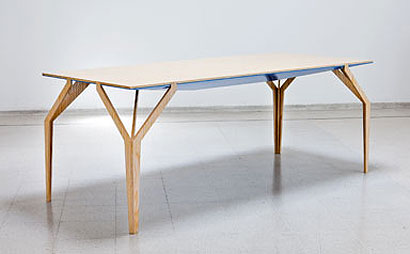|
It’s a tough time to leave university. But in the face of debt, an uncertain economy and fierce competition for work, these 15 design graduates have, between them, amassed an outstanding collection of innovative and diverse projects: perfect launch pads for life beyond the classroom.
Lingjing Yin
RCA, MA Design Products
Touch the Sound
Lingjing Yin started her graduation project by developing a technology that translated touch to sound. She then had to find useful applications for it. First, she worked with two dancers from south London’s Trinity Laban Conservatoire to choreograph “a performance based on touch and changing gestures”. Each dancer stood on a coloured mat laced with sensors that turned their movements into strains of specially composed music. Yin went on to create a device for an autistic child that recorded sound, but could play it back only when it touched someone else, encouraging social and physical interaction. Yin’s device was awarded the RCA’s Helen Hamlyn Award for people-centred design.

Kips Davenport
London Metropolitan University, FdA Furniture Making
All Angles Table
To produce All Angles Table, a dining table with a top that dramatically cantilevers over its four corner legs, Kips Davenport had to learn as much about engineering as he did furniture design. “The shape has been driven by the idea of taking away as much material as possible but retaining structural strength,” Davenport says. A torsion box structure braced with two skins of thin ash ply – a form similar to the wing of an airplane – gives the table span its rigidity. The table’s blue-lacquered underbelly is intended to draw the eye to its unusual shape and details.

Tom Jarvis
RCA, MA Design Products
Tools to Service an Orchestra
Tom Jarvis’ project came from a desire to make objects that fulfil real needs. The beautifully made metal and wood hand tools have been designed to address the problems of repairing brass musical instruments – removing a stuck tuning slide on a French horn, for example. Designing the tools required in-depth knowledge of each instrument, and Jarvis studied closely the safest places to apply pressure or lever the parts. “They’re like very niche Swiss army knives,” he says. Along with the tools, there’s a lightweight inflatable carrying case for a double bass, ingeniously solving the problem of storing large hard-skinned cases.

Oscar Medley-Whitfield
Kingston University, BA Product and Furniture Design
Worth the Weight
For his final project, Oscar Medley-Whitfield presented a collection of bowls moulded from scrap copper. Each piece is made by pouring the molten metal into a cloth that sits at the base of a pot of water. It’s an ancient Japanese method that uses water to slow the cooling of the metal and release of oxygen that leaves the material brittle and unusable. The pieces are still very much at the experimental stage, but they function as “a celebration of what the process can produce”, Medley-Whitfield says. You can see them alongside works by Barber Osgerby and Max Lamb for the Aram Gallery exhibition Casts and Moulds, on show until 27 August.

Freyja Sewell
University of Brighton, BA 3D Design
Hush
Freyja Sewell’s project appeals to the hermit in all of us. The Brighton graduate describes Hush as “a womb, a burrow or a cocoon”, designed for people who want a bit of privacy in open-plan offices, airports or shared houses. “iPhones, webcams … there are so many ways for people to connect nowadays,” she says. “But we’ve forgotten that people like to be alone sometimes too.” The thick felt (normally used as insulation) is stitched around a circular base and can be peeled outwards to form a chair. Sewell is currently talking to soft furniture manufacturer Fatboy about putting Hush into production.

|
|
Image
Peter Guenzel
Words
Riya Patel
|

















